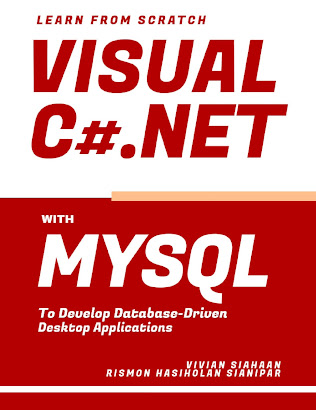In
Tutorial 2, you will build a school inventory project where you can store
information about valuables in school. The table will have nine fields: Item
(description of the item), Quantity, Location (where the item was placed), Shop
(where the item was purchased), DatePurchased (when the item was purchased),
Cost (how much the item cost), SerialNumber (serial number of the item),
PhotoFile (path of the photo file of the item), and Fragile (indicates whether
a particular item is fragile or not).
In Tutorial 3, you will perform the steps
necessary to add 5 new tables using phpMyAdmin into Academy database. You will
build each table and add the associated fields as needed. Every table in the
database will need input form. In this tutorial, you will build such a form for
Author table. Although this table is quite simple (only four fields: AuthorID,
Name, BirthDate, and PhotoFile), it provides a basis for illustrating the many
steps in interface design. SQL statement is required by the Command object to
read fields (sorted by Name). Then, you will build an interface so that the
user can maintain the Publisher table in the database (Academy). The Publisher
table interface is more or less the same as Author table interface. This
Publisher table interface only requires more input fields. So you will use the
interface for the Author table and modify it for the Publisher table.
In Tutorial 4, you will perform the steps
necessary to design and implement title form, library member form, and book
borrowal form. You start by designing and testing the basic entry form for book
titles. The Title table has nine fields: BookTitle, PublishYear, ISBN,
PublisherID, AuthorID, Description, Note, Subject, and Comment. Then, you will
build such a form for Member table. This table has twelve fields: MemberID,
FirstName, LastName, BirthDate, Status, Ethnicity, Nationality, Mobile, Phone,
Religion, Gender, and PhotoFile). You need thirteen label controls, one picture
box, six text boxes, four comboxes, one check box, one date time picker, one
openfiledialog, and one printpreviewdialog. You also need four buttons for
navigation, six buttons for controlling editing features, one button for
searching member’s name, and one button to upload member’s photo. Finally, you
will build such a form for Borrow table. This table has seven fields: BorrowID,
MemberID, BorrowCode, ISBN, BorrowDate, ReturnDate, and Penalty. In this form,
you need fourteen label controls, seven text boxes, two comboxes, two date time
pickers, and one printpreviewdialog. You also need four buttons for navigation,
seven buttons for other utilities, one button to generate borrowal code, and
one button to return book.
Vivian Siahaan is a fast-learner who likes to do new things. She was born, raised in Hinalang Bagasan, Balige, on the banks of Lake Toba, and completed high school education from SMAN 1 Balige. She started herself learning Java, Android, JavaScript, CSS, C ++, Python, R, Visual Basic, Visual C #, MATLAB, Mathematica, PHP, JSP, MySQL, SQL Server, Oracle, Access, and other programming languages. She studied programming from scratch, starting with the most basic syntax and logic, by building several simple and applicable GUI applications. Animation and games are fields of programming that are interests that she always wants to develop. Besides studying mathematical logic and programming, the author also has the pleasure of reading novels. Vivian Siahaan has written dozens of ebooks that have been published on Sparta Publisher: Data Structure with Java; Java Programming: Cookbook; C ++ Programming: Cookbook; C Programming For High Schools / Vocational Schools and Students; Java Programming for SMA / SMK; Java Tutorial: GUI, Graphics and Animation; Visual Basic Programming: From A to Z; Java Programming for Animation and Games; C # Programming for SMA / SMK and Students; MATLAB For Students and Researchers; Graphics in JavaScript: Quick Learning Series; JavaScript Image Processing Methods: From A to Z; Java GUI Case Study: AWT & Swing; Basic CSS and JavaScript; PHP / MySQL Programming: Cookbook; Visual Basic: Cookbook; C ++ Programming for High Schools / Vocational Schools and Students; Concepts and Practices of C ++; PHP / MySQL For Students; C # Programming: From A to Z; Visual Basic for SMA / SMK and Students; C # .NET and SQL Server for High School / Vocational School and Students. At the ANDI Yogyakarta publisher, Vivian Siahaan also wrote a number of books including: Python Programming Theory and Practice; Python GUI Programming; Python GUI and Database; Build From Zero School Database Management System In Python / MySQL; Database Management System in Python / MySQL; Python / MySQL For Management Systems of Criminal Track Record Database; Java / MySQL For Management Systems of Criminal Track Records Database; Database and Critptography Using Java / MySQL; Build From Zero School Database Management System With Java / MySQL.
























